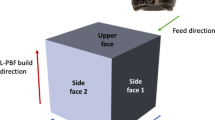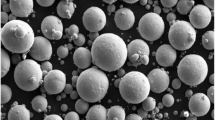Abstract
Hybrid manufacturing approaches with additive and subtractive manufacturing is a promising technology for many sectors from personal care goods to aerospace. When it comes to the residual stresses, there are hardly about the additive manufacturing (AM). Although some researches have been conducted for the hybrid laser additive manufacturing and subtractive manufacturing (SM) processes, only the machining parameters, material properties, and surface quality were analyzed; there were a few experiments about the residual stresses. Taking this into account, this paper aims to analyze the surface residual stresses in hybrid manufacturing approaches. Additive machining process, electrochemical corrosion, and surface residual stresses testing were described in detail. The main results of the research would be references for the surface residual stresses when 316L stainless steel specimens are manufactured with laser metal deposition and milling after AM immediately. The oxidation is much serious in additive manufacturing, and the surface tensile stresses are quite small. Both the electrochemical corrosion and milling at high temperature will affect the distribution of the surface residual stresses. The residual tensile stresses are distributed symmetrically after milling process while they are asymmetric after electrochemical corrosion.
Similar content being viewed by others
References
Lin C, Fan Y, Zhang Z, Fu G, Cao X (2016) Additive manufacturing with secondary processing of curve-face gears. Int J Adv Manuf Technol 86(1–4):9–20
Espalin D, Muse DW, MacDonald E, Wicker RB (2014) 3D printing multifunctionality: structures with electronics. Int J Adv Manuf Technol 72(5–8):963–978
Qi H, Azer M, Singh P (2010) Adaptive toolpath deposition method for laser net shape manufacturing and repair of turbine compressor airfoils. Int J Adv Manuf Technol 48(1):121–131
Ding D, Pan Z, Cuiuri D, Li H (2015) Wire-feed additive manufacturing of metal components: technologies, developments and future interests. Int J Adv Manuf Technol 81(1–4):465–481
Huang SH, Liu P, Mokasdar A, Hou L (2013) Additive manufacturing and its societal impact: a literature review. Int J Adv Manuf Technol 67(5–8):1191–1203
Shamsaei N, Yadollahi A, Bian L, Thompson SM (2015) An overview of direct laser deposition for additive manufacturing; part II: mechanical behavior, process parameter optimization and control. Additive Manufacturing 8:12–35
Karunakaran KP, Suryakumar S, Pushpa V, Akula S (2010) Low cost integration of additive and subtractive processes for hybrid layered manufacturing. Robot Comput Integr Manuf 26(5):490–499
Karunakaran KP, Suryakumar S, Pushpa V, Akula S (2009) Retrofitment of a CNC machine for hybrid layered manufacturing. Int J Adv Manuf Technol 45(7):690–703
Ye Z, Zhang Z, Jin X, Xiao MZ, Su J (2017) Study of hybrid additive manufacturing based on pulse laser wire depositing and milling. Int J Adv Manuf Technol 88(5–8):2237–2248
Luo X, Frank MC (2010) A layer thickness algorithm for additive/subtractive rapid pattern manufacturing. Rapid Prototyp J 16(2):100–115
Frank MC, Peters F, Karthikeyan RK (2010) Additive/subtractive rapid pattern manufacturing for casting patterns and injection mold tooling[C]// Proceedings of the Solid Freeform Fabrication Symposium, Austin, pp 242–255
Townsend V, Urbanic J (2012) Relating additive and subtractive processes in a teleological and modular approach. Rapid Prototyp J 18(4):324–338
Luo X, Li Y, Frank MC (2013) A finishing cutter selection algorithm for additive/subtractive rapid pattern manufacturing. Int J Adv Manuf Technol 69(9–12):2041–2053
Newman ST, Zhu Z, Dhokia V, Shokrani A (2015) Process planning for additive and subtractive manufacturing technologies. CIRP Ann Manuf Technol 64(1):467–470
Zhu Z, Dhokia V, Newman ST (2012) A novel process planning approach for hybrid manufacturing consisting of additive, subtractive and inspection processes[C]//Industrial Engineering and Engineering Management (IEEM), 2012 IEEE International Conference on. IEEE 1617–1621
Kerbrat O, Mognol P, Hascoët JY (2010) Manufacturability analysis to combine additive and subtractive processes. Rapid Prototyp J 16(1):63–72
Paris H, Mokhtarian H, Coatanéa E, Museau M, Ituartec IF (2016) Comparative environmental impacts of additive and subtractive manufacturing technologies. CIRP Ann Manuf Technol 65(1):29–32
Manogharan G, Wysk RA, Harrysson OLA (2016) Additive manufacturing–integrated hybrid manufacturing and subtractive processes: economic model and analysis. Int J Comput Integr Manuf 29(5):473–488
Jackson MA, Van AA, Morrow JD, Min S, Pfefferkorn FE (2016) A comparison of energy consumption in wire-based and powder-based additive-subtractive manufacturing. Procedia Manufacturing 5:989–1005
Pandey PM, Reddy NV, Dhande SG (2003) Improvement of surface finish by staircase machining in fused deposition modeling. J Mater Process Technol 132(1):323–331
Salonitis K, Alvise L, Schoinochoritis B, Chantzis D (2016) Additive manufacturing and post-processing simulation: laser cladding followed by high speed machining. Int J Adv Manuf Technol 85(9–12):2401–2411
Yang Y, Li M, Li KR (2014) Comparison and analysis of main effect elements of machining distortion for aluminum alloy and titanium alloy aircraft monolithic component. Int J Adv Manuf Technol 70(9–12):1803–1811
Zhu Z, Dhokia V, Nassehi A, Newman ST (2016) Investigation of part distortions as a result of hybrid manufacturing. Robot Comput Integr Manuf 37:23–32
Zaeh MF, Branner G (2010) Investigations on residual stresses and deformations in selective laser melting. Prod Eng 4(1):35–45
Carroll BE, Palmer TA, Beese AM (2015) Anisotropic tensile behavior of Ti–6Al–4V components fabricated with directed energy deposition additive manufacturing. Acta Mater 87:309–320
Mercelis P, Kruth JP (2006) Residual stresses in selective laser sintering and selective laser melting. Rapid Prototyp J 12(5):254–265
Vrancken B, Cain V, Knutsen R, Humbeeck JV (2014) Residual stress via the contour method in compact tension specimens produced via selective laser melting. Scr Mater 87:29–32
Liang YJ, Liu D, Wang HM (2014) Microstructure and mechanical behavior of commercial purity Ti/Ti–6Al–2Zr–1Mo–1V structurally graded material fabricated by laser additive manufacturing. Scr Mater 74:80–83
Moat RJ, Pinkerton AJ, Li L, Withers PJ, Preuss M (2011) Residual stresses in laser direct metal deposited Waspaloy. Mater Sci Eng A 528(6):2288–2298
Schoinochoritis B, Chantzis D, Salonitis K (2017) Simulation of metallic powder bed additive manufacturing processes with the finite element method: a critical review. Proc Inst Mech Eng B J Eng Manuf 231(1):96–117
Buchbinder D, Meiners W, Pirch N, Wissenbach K (2014) Investigation on reducing distortion by preheating during manufacture of aluminum components using selective laser melting. J Laser Appl 26(1):012004
Bagherifard S, Roscioli G, Zuccoli MV, hadi m EG, Demir AG, Previtail B, Kondas J, Guagliano M (2017) Cold spray deposition of freestanding Inconel samples and comparative analysis with selective laser melting. J Therm Spray Technol 26(7):1517–1526
Wang T, Zhu YY, Zhang SQ, Tang HB, Wang HM (2015) Grain morphology evolution behavior of titanium alloy components during laser melting deposition additive manufacturing. J Alloys Compd 632:505–513
Vilar R, Almeida A (2015) Repair and manufacturing of single crystal Ni-based superalloys components by laser powder deposition—a review. J Laser Appl 27(S1):S17004
Zhu Y, Li J, Tian X, Wang H, Liu D (2014) Microstructure and mechanical properties of hybrid fabricated Ti–6.5 Al–3.5 Mo–1.5 Zr–0.3 Si titanium alloy by laser additive manufacturing. Mater Sci Eng A 607:427–434
Nasr MNA, Ng EG, Elbestawi MA (2007) Modelling the effects of tool-edge radius on residual stresses when orthogonal cutting AISI 316L. Int J Mach Tools Manuf 47(2):401–411
Ya M, Xing Y, Dai F, Lu K, Lu J (2003) Study of residual stress in surface nanostructured AISI 316L stainless steel using two mechanical methods. Surf Coat Technol 168(2–3):148–155
Luo KY, Jing X, Sheng J, Sun GF, Yan Z, Lu JZ (2016) Characterization and analyses on micro-hardness, residual stress and microstructure in laser cladding coating of 316L stainless steel subjected to massive LSP treatment. J Alloys Compd 673:158–169
Wu AS, Brown DW, Kumar M, Gallegos GF, King WE (2014) An experimental investigation into additive manufacturing-induced residual stresses in 316L stainless steel. Metall Mater Trans A 45(13):6260–6270
Acknowledgments
The author would like to thank Lele Feng for her encouragement and support.
Funding
This was supported by the National Natural Science Foundation of China (No. 51775100, No. 51505073 and No. 51375082) and the Fundamental Research Funds for the Central Universities (No. N170306003 and No. N170304022).
Author information
Authors and Affiliations
Corresponding author
Rights and permissions
About this article
Cite this article
Li, P., Gong, Y., Wen, X. et al. Surface residual stresses in additive/subtractive manufacturing and electrochemical corrosion. Int J Adv Manuf Technol 98, 687–697 (2018). https://doi.org/10.1007/s00170-018-2283-4
Received:
Accepted:
Published:
Issue Date:
DOI: https://doi.org/10.1007/s00170-018-2283-4




